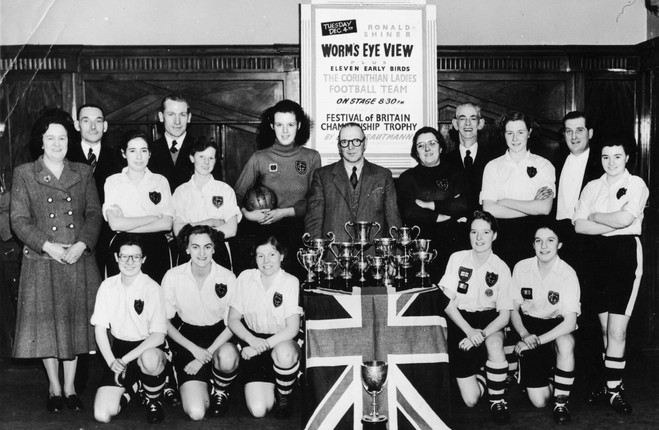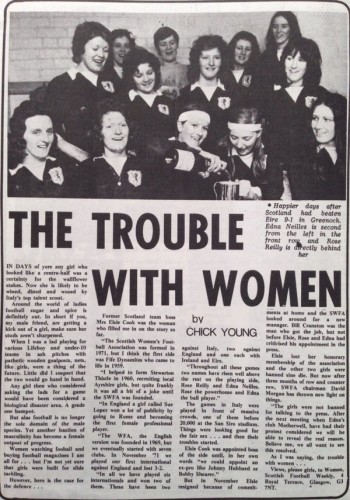IN RECENT YEARS, women’s sport in Ireland has made considerable progress.
In GAA, attendances for All-Ireland finals have consistently been broken. In rugby, the Irish team have beaten New Zealand among other notable triumphs. In soccer, a historic protest from the women’s national team has led to better working conditions and improving results. And outside of those big three sports, there has also been the remarkable success of the Irish hockey team in addition to individuals such as Katie Taylor achieving historic feats.
There is still plenty of work to do, of course, otherwise there would be no need for welcome initiatives such as the 20×20 campaign.
And while women’s sport in this country has developed in a positive fashion over the past decade, it would be too simplistic to suggest it was not popular and there were no breakthrough moments up until quite recently. In fact, for decades, there have been a number of advancements and setbacks.
In 2015, The42 spoke to scholar David Toms about the prominence of women’s soccer in Ireland and elsewhere in the 1920s, with as many as 12,000 supporters attending a match between a Dublin selection and Scotland at Milltown. Exactly why it struggled to maintain such popularity in the intervening decades is a complex issue, with a number of factors having an impact, such as people’s increasingly narrow-minded view of women’s sport and the subsequent widespread efforts to limit its presence in an increasingly conservative society. Mass emigration and the institutionalisation of women by the church and the state exacerbated this dwindling female representation. In addition, it was a time when it was widely thought that ‘a women’s place was at home,’ as the Eamon de Valera-drafted constitution in 1937 indicated.
And while it is easy enough to ascertain why women’s sport struggled to be taken seriously in Ireland for large portions of 20th century and thereafter to a degree, the information that exists on the subject remains limited and consequently, people’s knowledge of these issues tends to be quite vague.
Consequently, Helena Byrne and four other researchers — Martin J Moore, Stuart Gibbs, Michael Kielty and Gerard Farrell — are currently working on a project that aims to “document the history and development of women’s football”.
In 1973, women’s football governing bodies were established and structures were put in place that have been developed in the intervening years. Prior to that period, however, there is a conspicuous lack of information. Byrne and her colleagues seek to explore this forgotten history, and have formed a crowdsourcing project to share citations of Irish women’s football in newspapers prior to 1973.
Byrne’s research has focused largely on indoor football, which was popular among both men and women in the 1960s.
Curiously, indoor football managed to escape the GAA’s ban on its members playing foreign games, which took full effect in 1905 and was not officially revoked until 1971.
“There were GAA players playing it who were getting away with the ban,” Byrne explains. “In some cases, it was seen as entertainment, or just the GAA looked the other way because it was so popular — they’d have crowds of thousands in to watch the matches during the week.
“They’d have a couple of men’s matches, then two or three women’s matches, and more men’s matches. Women were encouraged to play, so that’s how contemporary women’s soccer and Gaelic football started. The women were playing indoor football and moved on to outdoor soccer or outdoor Gaelic. They lifted the ban on GAA players playing foreign sports in the early ’70s. Then the popularity of indoor football had served its time and was a springboard for other activities.”
On the rise of indoor football, Byrne continues: “They had the ads in the entertainment section. They did have some reporting of the matches and the rules and stuff like that, but they weren’t in the sports section, so I think in Drogheda it was seen as entertainment rather than sport. But in Dundalk, they had North Louth sports awards and a woman won the indoor football section of it.
I had a talk in February in Dundalk. Somebody there told me they were playing a competition in Monaghan and the GAA players wore the same jersey with the number 3 on the back just in case they got suspended, so if they’re all number 3 from the same club, they’re never going to know who they are.
“There were other interviews in the Dundalk newspapers as well. They interviewed two prominent GAA figures who were in the crowd. They said it was great but in other areas, it didn’t get received very well. It was so popular that they couldn’t be seen to be coming down hard on it.
“It was a lot [about] the ban and that’s how the debate started in the late 1960s about the future of the ban. It was in that in-between phase. There’s an organisation that call themselves the All-Ireland Indoor Football Association. They said that they’d sent the rules out to 1,000 places and they were hoping this would bridge the gap between the GAA and other codes of football. People organising women’s football were actively trying to break down the barriers that existed. I tried the GAA archives to see if they’d any records of correspondence [in relation to] indoor football, but they don’t seem to have anything.
I’m looking more into their relationship with camogie, because camogie never had that ban as the GAA did. But in ’67, they got one in because indoor football was so popular among camogie players. Lots of prominent camogie players got banned because they were playing indoor football. A north Louth team had won the Louth Championships for a number of years and they lost because five of their players were suspended. And then when the suspension was over, they won it again the next couple of years.”
Byrne, who works as a librarian in web archiving and undertakes the research in her spare time, plans to keep digging in the coming months as she bids to help people gain a more comprehensive understanding of this intriguing and overlooked subject area.
“I’m still working on indoor football research with former players, because it really is a forgotten history. It hasn’t been documented anywhere. There’s no legacy archive or anything left behind. It was a really important part of Irish sporting history. It broke down a lot of barriers.”
You can find more info on the work undertaken by Helena Byrne and her colleagues here.
Gavan Casey and Murray Kinsella are joined by Andy Dunne to get stuck into last weekend’s Champions Cup semi-finals.:
The42 Rugby Weekly / SoundCloud
Subscribe to our new podcast, The42 Rugby Weekly, here:


